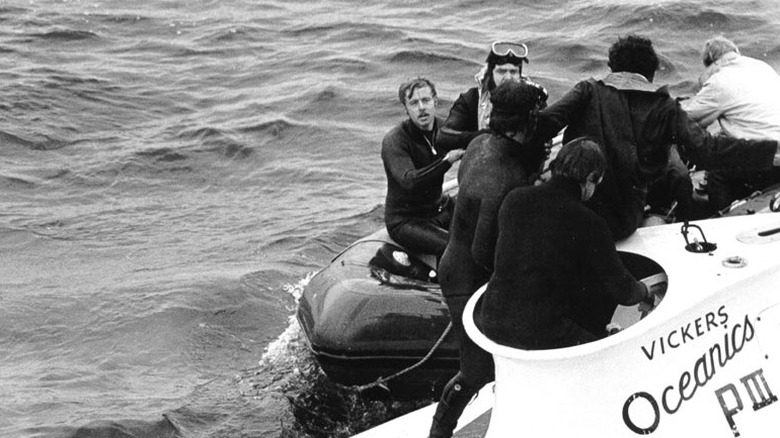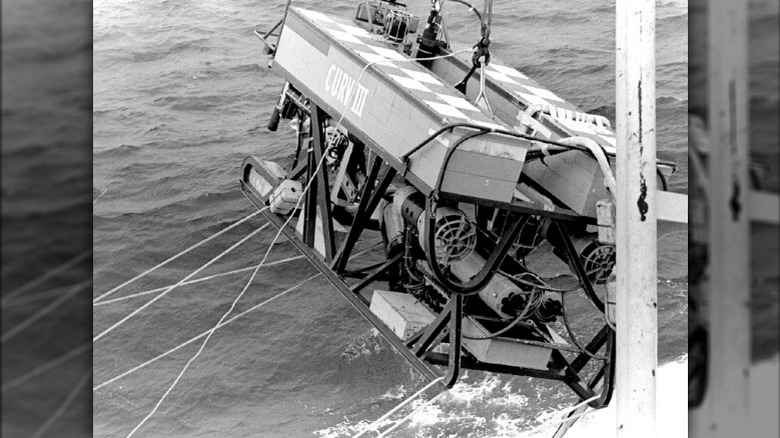The Daring Underwater Rescue Of Pisces III In 1973
The banging sounds were nothing out of the ordinary. In August 1973, British Royal Navy submariner Roger Chapman — along with engineer Roger Mallinson — were roughly 150 miles off the coast of Ireland in the Celtic Sea. Chapman and Mallinson were at that depth laying transatlantic telephone cable in a commercial submersible called Pisces III — defined as a small underwater craft with less power than a submarine, and requiring a tow from a larger vessel to submerge and surface (via Insider).
At the end of their routine shift, the Pisces III was about to be reattached to the cables from the mother ship. That's when it all went wrong, Chapman told BBC News. "There was lots of banging of ropes and shackles," he said, but that was not abnormal during an operation's final phase. In an accident, though, a part of the submersible flooded, adding weight to the craft and causing it to sink. Suddenly, "we were hurtled backward and sank rapidly. We were dangling upside down, then heaved up like a big dipper," he said.
By the time the two men landed, they were more than 1,500 feet underwater. Recalling their 30-second fall before settling at the bottom, Mallinson later said (via BBC News), "It was very frightening — like a Stuka dive bomber with screaming motors and the pressure gauges spinning around." To this day, the Pisces III's recovery (seen above) is the deepest underwater rescue in history, according to NPR.
[Featured image by United States Navy via Wikimedia Commons | Cropped and scaled]
Chapman and Mallinson had 66 hours of oxygen
Luckily, Roger Chapman and Roger Mallinson had a fresh oxygen tank on the Pisces III with a 66-hour supply, according to IFLScience. Once at the bottom, the two experienced submariners knew that oxygen preservation was crucial, so they both attempted to breathe as little as possible and kept talking at a minimum. They'd not only hit the bottom of the Celtic Sea — the Pisces III was even a bit further down, in a gully.
Also fortuitous, Chapman and Mallinson managed to contact the surface: They were alive, and for now, they were fine. Once at the bottom, Mallinson and Chapman checked for leaks and cleaned up their scattered equipment, cast asunder by the fall. The submersible itself had landed upside down. "We hardly spoke, just grabbing each other's hand and giving it a squeeze to show we were alright. It was very cold — we were wet through. ... But our job was to stay alive," Mallinson told BBC News.
Chapman added, "We allowed the CO2 to build up a bit to conserve oxygen — we had egg timers to keep track of every 40 minutes, but we'd wait a bit longer. It made us a bit lethargic and drowsy." By that point, the rescue mission was underway. Teams deployed from the U.S., Canada, and the U.K, but throughout a series of mishaps and setbacks, Chapman and Mallinson remained for roughly three days in what was — for all they knew — a watery grave. (The CURV III, used in the Pisces III rescue operation, can be seen above.)
[Featured image by United States Navy via Wikimedia Commons | Cropped and scaled]
Rescuers weren't sure exactly where Pisces III was
Although Roger Chapman and Roger Mallinson had contacted the surface, Pisces III's exact location was unclear. As it sank, Pisces III lost its buoy, and locating it was the first major hurdle to overcome. According to author Stephen McGinty — who wrote the 2022 book "The Dive: The Untold Story of the World's Deepest Submarine Rescue" about the Pisces III — Chapman sang in hopes sonar might pick up his signal. It worked, and the first major obstacle to bring Chapman and Mallinson home was complete, though the challenge was far from over.
In 2021, McGinty told Newsweek, "The plan was relatively simple: A sister sub would go down with a two-man crew and attach a specially designed grapple hook to the sub then lift it to the surface." As a series of subs attempted to attach lift lines to the Pisces III, a number of things went wrong, until finally, two rescue hooks were attached, and the Pisces III was slowly lifted toward safety.
With rescue at hand, the two men's ordeal continued, as that process itself proved challenging. In an agonizing succession of stops and starts, Mallinson and Chapman (pictured above) swung back and forth violently until they reached the surface. Chapman told BBC News that rescuers "thought we'd died when they looked at us, it had been so violent." By the time the two men reemerged in fresh air, Chapman said they had only 12 minutes of oxygen left.


